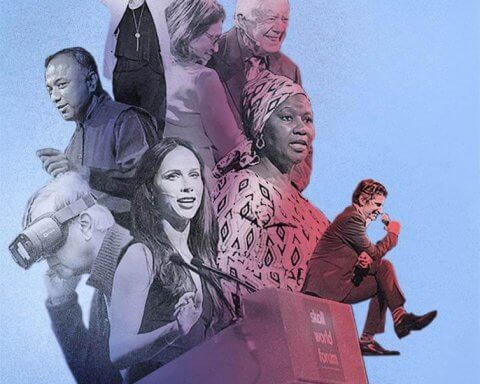Last year, a University of Toronto student emailed the editors of The Varsity with a story idea about a local food service company. The student hadn’t written previously for the newspaper, which is geared at the university’s 60,000 undergraduates, but he still got the assignment. After the piece ran, editorial staff discovered the author was actually a social media “brand ambassador” for the company, and the newspaper decided to pull the article from its website.
Editor-in-chief Danielle Klein says she is deluged with online solicitations from students who have struck promotional deals with the marketers of products, local clubs or other advertisers. Using their personal social media accounts, they tweet or post on various social media platforms for the brands, but they also come forward with offers to help news organizations like The Varsity write articles promoting certain products or services, typically without disclosing their connection. “I find that quite dishonest, because you’re representing that ad as content,” says Klein.
Apart from the journalistic breaches, Klein adds that she’s struck by the terms of those agreements – in exchange for promotional tweets or posts tucked into their newsfeeds, these young brand ambassadors often get freebees, and perhaps a bit of cash or “resumé lines.”
“That’s a problem,” she says. “It’s sort of tricking people.”
Welcome to the wild west of social media marketing. With young people turning away from Facebook, marketers focused on this huge demographic segment have turned to new, and ethically problematic, ways of reaching audiences that are spending much more of their time on established or emerging platforms like Instagram, Twitter and Snapchat. Unlike Facebook with its unmistakable in-your-face promotions, these other platforms have become vulnerable to a stealthier type of marketing, one that doesn’t come tagged as advertising.
In the past year, according to Toronto social media marketer Steve Tam, some brands have sought to establish marketing relationships with so-called “teen influencers” – young people who aren’t celebrities but have nonetheless built up such large social media followings that their feeds become interesting to marketers looking to reach specific audiences.
It’s a practice that has raised eyebrows, and not only with student newspaper editors. “People have to know they are being advertised to,” observes Chris MacDonald, an associate professor of business who established Ryerson University’s Jim Pattison Ethical Leadership Education and Research Program. Marketers, he adds, “can’t absolve themselves [of that obligation] by using a third party.
Cristina Onose, manager of public affairs for the Canadian Marketing Association, points to her organization’s guidelines for marketing to teenagers, as well as Canadian and international regulations which require advertisers to “properly disclose” their promotional activities. “Responsible organizations advertising online are expected to be transparent about their advertising techniques,” she says.
But the reality, as student editor Klein observes, is quite different. These brands and their youthful ambassadors understand that a positive tweet hidden inside an individual’s newsfeed – a message that goes out to hundred or thousands of followers – is “the best way to disguise” an ad.
It’s like a word-of-mouth endorsement… except that it’s not.
The story of how social media advertising is morphing into a no-holds-barred marketing environment begins with an unexpected twist: an exodus of young Internet users from Facebook, the original social networking giant.
According to a recent survey of 7,200 students by U.S. investment bank Piper Jaffray, teen interest in Facebook has been falling precipitously. It found that 45 per cent of surveyed teens were using Facebook as of fall 2014, down dramatically from 72 per cent just six months earlier. The drop was so steep, reported Bloomberg, that “Facebook stopped discussing teen usage on its earnings calls after last year’s disclosure alarmed investors.”
(Of note is that Facebook, in an unusual and some say desperate move, launched a print and TV ad campaign in Toronto and Vancouver this past February aimed at building a stronger emotional connection with young users. Marketing experts believe it’s a trial run of a planned larger campaign designed to help stem its Millennial and Gen Z exodus).
Morgan Baskin, a 19-year-old Toronto high school graduate, articulates her recent thinking about the social network with which she came of age. “Honestly,” she says, “like a lot of young people, Facebook for me is like a utility, like a washing machine. It’s a way of facilitating my life. It’s nothing I’m excited to use.”
Then Baskin offers up this right hook to social media marketers: “I ignore 95 per cent of Facebook advertising. There’s so much of it and none of it is clever.” She mentions one aggravation – a proliferation of male cosmetic products on her feed. “Why are you trying to sell me beard oil?” she laughs, speculating it’s because she clicks on hipster websites too often. “Their algorithm is clearly screwed up.”
This teen breakup with Facebook hardly indicates a mounting indifference among young people to social media. Other less commercialized platforms, like Instagram and Tumblr, remain as popular as ever, while the social media space in the past year or two has become increasingly populated by new entrants: Snapchat, Whisper, Vine, and Yik-Yak, all of them providing the kind of knowing and insider-y appeal that Facebook alone delivered to those millions of early adopters a decade ago.
Ever since the early days of Facebook, young people flocked to social media sites because they promised a world free of adult concerns and supervision. “I remember that feeling of being part of something that no one else was part of,” recounts Tam.
Yet as soon as social media platforms became popular and their popularity can be quantified by analytics software, the advertising followed. Those revenues offered the only way for social media companies to remain viable after their founders burned through angel and venture capital, but the presence of advertising also made the user experience more commercial.
In other words, the problem with the social media business model may be the fact that there’s a business model at all. Says Angelo Dodaro, a partner at boutique digital agency Multivitamin Media: “Young people who grew up with social media are running away from commercialization.”
Or are they? Consider the case of Alex Lee, a baby-faced Texan teenager. In a matter of days last fall, Lee went from being an unremarkable 16 year old to an Internet phenomenon – one of those instant digital celebrities created by the law of exponential growth.
Lee, who looks like a young Justin Beiber, was working as a bagger at his local Target when someone snapped his photo. A couple of shares later, the image was moving through the account of a U.K.-based Instagram user with a large following.
The law of viral growth clicked in, and within days, Lee’s Twitter account had hundreds of thousands of followers. Teenage girls started showing up at the Target to ogle. The mainstream media soon detected the Alex Lee supernova on the horizon, and interview requests from CNN and the New York Times, among other media outlets, flowed in.
Speculation about Target’s role in the Alex Lee story spread almost as quickly. After all, the company’s brand had just received the equivalent of a steroid injection, just in time for Christmas. A Los Angeles social media-marketing firm took credit, but the company denied authorship. To this day, the answer remains unclear.
The more intriguing part of the Alex Lee story, however, started after that initial whoosh of attention. Lee had become “an influencer,” but not the conventional celebrity sort of influencer, like a hip-hop artist, a movie star or a professional athlete. Rather, he was influential because he was a kid with a large following.
In fact, Lee moved swiftly from viral Internet celebrity to a celebrity teen influencer with something to sell. His Twitter feed is now populated by pitches for a new phone app as well as an outfit that bills itself as a social media tour and music festival. (He also has a website that sells branded Alex Lee World products.)
Young people with large followings understand that social media thrives on clever, funny and ironic content – memes, gifs, or the tsunami of photos and mini-videos on Snapchat, a platform that allows users to converse using images that last for only a few seconds. With highly engaged followers, their feeds are perfect environments for promotional pitches.
“It’s a new vehicle that is definitely picking up momentum,” says Tam. Most will never get past the sort of brand ambassador stage. But others, he adds, have such huge followings that they hire agents to negotiate fees and arrange appearances. “Their parents may not even know this is something that’s happening.”
 This type of promotion is a relatively new feature of our noisy media environment. Despite codes of conduct promoted by advertising standards organizations, the line between online editorial and advertiser content has become increasingly blurry in recent years. Bloggers, for example, strike agreements with advertisers that allow brands to sponsor user forums in exchange for invitations to events, samples and so on.
This type of promotion is a relatively new feature of our noisy media environment. Despite codes of conduct promoted by advertising standards organizations, the line between online editorial and advertiser content has become increasingly blurry in recent years. Bloggers, for example, strike agreements with advertisers that allow brands to sponsor user forums in exchange for invitations to events, samples and so on.
But tweets and posts sent out by youthful brand ambassadors or teen influencers are stripped of all disclosure-related content, even though the brand’s marketing officials likely vetted them.
As MacDonald points out, this new relationship between brands and teen influencers is anything but even. “The advertising people are supposed to know about the ethics of advertising, whereas you can’t expect a young teen to be familiar with advertising ethical standards or think it through by themselves.”
Besides trying to reach young consumers in new ways, brands may also be thinking about getting the most bang for their marketing bucks. It’s one thing to pay a supermodel or a star athlete millions of dollars to promote a product, and quite another to avoid those outlays by offering a few dollars or t-shirts to students with lots of social media followers.
Increasingly, brands are opting for other rapidly emerging tactics that hook young consumers with the kind of content they are constantly exchanging on their own feeds. Jack Harding, the director of user engagement for Poolhouse, a Toronto advertising agency and blog publisher, says some innovative marketers are establishing direct online relationships with social media users who have tweeted or posted positive messages or images about a client’s brands. The brand – or its marketers – constantly scour social media networks for favourable mentions, and then reach out to unsuspecting teens with offers of discounts or gifts.
“Users are always shocked [when they get a message from a brand], but in a good way,” says Harding. “When it does happen, it’s really unique. This conversation is something no one else has had before. It makes you feel special and more connected to the brand.”
Yet brands aren’t just trading freebies for mentions. Poolhouse, for example, publishes a website called ThreeMillionDogs that offers pet-related content and is funded by pet-product advertising. To better engage younger followers of the site, Harding, 22, started producing very short videos to send to Snapchat users. He’ll grab a snippet of a Top 40 song and lay it over one of the countless number of funny pet videos circulating online.
One recent example: a clip of a dog lifting weights with Britney Spears singing “Work Bitch” in the background. When Harding posts these snaps, they’re not only passed around; they generate new followers, new videos and a dialogue with individual Snapchat users. Eventually, that Snapchat user will receive an image of a coupon for products featured on the ThreeMillionDogs site.
 The ongoing interaction, Harding observes, “builds trust. You now have a person-based approach to putting ads in front of people.” (These ads take him a few minutes to produce, and cost only his time. The return on investment is significant when compared to the enormous outlay required for more conventional advertising.)
The ongoing interaction, Harding observes, “builds trust. You now have a person-based approach to putting ads in front of people.” (These ads take him a few minutes to produce, and cost only his time. The return on investment is significant when compared to the enormous outlay required for more conventional advertising.)
Snapchat has become all-consuming for many teens, a trend identified early by fast-food retailer Taco Bell. The restaurant chain is recognized as one of the first firms to begin posting snaps, typically quick-and-cheerful images that have a homemade quality. Owned by PepsiCo, it has drawn the attention of brand marketers because of its especially adroit, youth-focused social media marketing methods. It was quick to spot the fast-moving teen transition to Snapchat, and in 2013 took a gamble on what was then a two-year-old and not yet fully evolved platform, says Harding. “They were on Snapchat six to 12 months before everyone else.”
Many others have since followed. Social media marketers are now intensively scrutinizing the ephemeral culture of Snapchat to better understand the platform’s youth appeal as a kind of antidote to Facebook’s relentless commercialization.
Morgan Baskin offers an instructive anecdote about Snapchat, having recently found herself totally absorbed with the snaps generated by the organizers of Fashion Week in New York. “I watched a ridiculous amount,” she says, noting that the images – smart phone photos taken next to runways and at backstage VIP events – seemed authentic and spontaneous. As she puts it, they feel like there’s a person, and a personality, behind the brand, which is precisely the point.
Ultimately, the question is whether this fast-emerging approach to social media advertising is causing undue harm to the impressionable young people to whom it’s targeted. Like many teenagers, Baskin is media savvy enough to understand the marketing imperative. If the content is clever enough, she says, “you don’t care.”
But Ryerson’s Chris MacDonald says the stories of covert marketing at and by teens should be ringing alarm bells within companies. Corporate social responsibility departments should be paying particular attention, given their mandate to think beyond compliance and embrace the highest standards of ethical conduct.
Advertisers, after all, are expected to adhere to all sorts of industry standards when they promote their products in other more established media. What is it about social media that permits those rules to be tossed out the window?
“If we’re seeing problems,” MacDonald says, “the blame has to start with the professionals and the adults who should really know better.”







